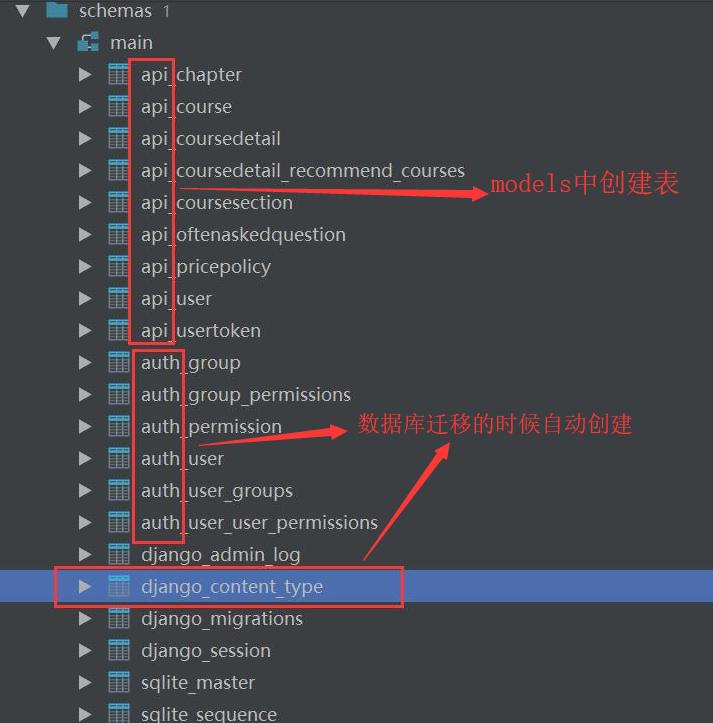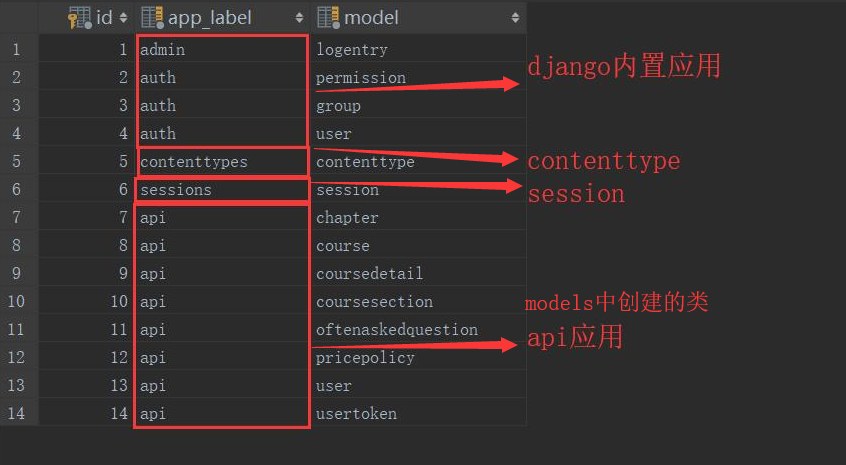ContentType组件
一、什么是ContentTypes
django提供的一个 快速连表操作的组件
contenttypes 是Django内置的一个应用,可以追踪项目中所有app和model的对应关系,并记录在ContentType表中。models.py文件的表结构写好后,通过makemigrations和migrate两条命令迁移数据后,在数据库中会自动生成一个django_content_type表:

每当我们创建了新的model并执行数据库迁移后,ContentType表中就会自动新增一条记录。比如我在应用api的models.py中创建表class Electrics(models.Model): pass。从数据库查看ContentType表,显示如下:

那么这个表有什么作用呢?这里提供一个场景,网上商城购物时,会有各种各样的优惠券,比如通用优惠券,满减券,或者是仅限特定品类的优惠券。在数据库中,可以通过外键将优惠券和不同品类的商品表关联起来:
from django.db import models class Electrics(models.Model): """ id name 1 日立冰箱 2 三星电视 3 小天鹅洗衣机 """ name = models.CharField(max_length=32) class Foods(models.Model): """ id name 1 面包 2 烤鸭 """ name = models.CharField(max_length=32) class Clothes(models.Model): name = models.CharField(max_length=32) class Coupon(models.Model): # 特殊关系表 """ id name electric_id food_id cloth_id more... # 每增加一张表,关系表的结构就要多加一个字段。 1 通用优惠券 null null null 2 冰箱满减券 2 null null 3 面包狂欢节 null 1 null """ name = models.CharField(max_length=32) electric = models.ForeignKey(to='Electrics', null=True) food = models.ForeignKey(to='Foods', null=True) cloth = models.ForeignKey(to='Clothes', null=True)
如果是通用优惠券,那么所有的ForeignKey为null,如果仅限某些商品,那么对应商品ForeignKey记录该商品的id,不相关的记录为null。但是这样做是有问题的:实
际中商品品类繁多,而且很可能还会持续增加,那么优惠券表中的外键将越来越多,但是每条记录仅使用其中的一个或某几个外键字段。
contenttypes 应用
通过使用contenttypes 应用中提供的特殊字段GenericForeignKey,我们可以很好的解决这个问题。只需要以下三步:
- 在model中定义ForeignKey字段,并关联到ContentType表。通常这个字段命名为“content_type”
- 在model中定义PositiveIntegerField字段,用来存储关联表中的主键。通常这个字段命名为“object_id”
- 在model中定义GenericForeignKey字段,传入上述两个字段的名字。
为了更方便查询商品的优惠券,我们还可以在商品类中通过GenericRelation字段定义反向关系。
ContentType
示例:
通过Django提供的ContentType表,来构建

models层创建:
from django.db import models from django.contrib.contenttypes.models import ContentType from django.contrib.contenttypes.fields import GenericForeignKey, GenericRelation class Course(models.Model): title = models.CharField(max_length=32) # 不会在数据库中生成字段,只用于数据库操作 # policy = GenericRelation('PricePolicy',object_id_field='object_id',content_type_field='contentType') class DegreeCourse(models.Model): title = models.CharField(max_length=32) class PricePolicy(models.Model): # 跟ContentType表做外键关联 contentType = models.ForeignKey(to=ContentType) # 正数 object_id = models.PositiveIntegerField() # 引入一个字段,不会在数据库中创建,只用来做数据库操作 # content_obj = GenericForeignKey('contentType', 'object_id') period = models.CharField(max_length=32) price = models.FloatField()
views层:
from app01 import models def test(request): import json # 方式一插入价格规则 # ret=models.ContentType.objects.filter(model='course').first() # course=models.Course.objects.filter(pk=1).first() # print(ret.id) # models.PricePolicy.objects.create(period='30',price=100,object_id=course.id,contentType_id=ret.id) # 方式二插入价格规则 # course=models.Course.objects.filter(pk=1).first() # # content_obj=course 会自动的把课程id放到object_id上,并且去ContentType表中查询课程表的id,放到contentType上 # models.PricePolicy.objects.create(period='60',price=800,content_obj=course) # 增加学位课,价格规则 # degreecourse = models.DegreeCourse.objects.filter(pk=1).first() # models.PricePolicy.objects.create(period='60', price=800, content_obj=degreecourse) # 查询所有价格策略,并且显示对应的课程名称 # ret=models.PricePolicy.objects.all() # for i in ret: # print(i.price) # print(i.period) # # content_obj 就是代指关联的课程,或者学位课程的那个对象 # print(type(i.content_obj)) # print(i.content_obj.title) # 通过课程id,获取课程信息和价格策略 course=models.Course.objects.filter(pk=1).first() print(course.policy.all()) return render(request,'test.html')

